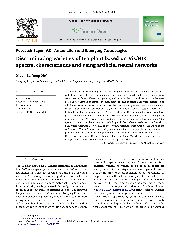摘要
A method for discriminating varieties of tea plant based on their visible/near infrared reflectance (Vis/NIR) spectral characteristics was developed. Field experiments were conducted in three different tea gardens, and 293 samples of the three tea varieties were selected for Vis/NIR spectroscopy measurement. The spectral data were pretreated to eliminate system noise and external disturbances; several pretreatments were evaluated for their discrimination accuracies. Diagnostic information was extracted mathematically to build the discrimination model. The methods were the integrated wavelet transform (WT), principal component analysis and artificial neural networks (ANN). The diagnostic information from WT was re-expressed and visualised in principal components (PCs) space, to determine the structure correlating with the different varieties. The first eight PCs, which accounted for 99.29% of the original variation, were used as the input to the ANN model. The ANN model yielded good classification accuracy with the proper spectral pretreatment and optimum WT parameter. The discrimination accuracy was 77.3% for these three varieties in the prediction set. The potential of Vis/NIR spectral characteristics was proved primarily for discrimination of tea plant varieties.
- 出版日期2008-3
- 单位浙江大学
